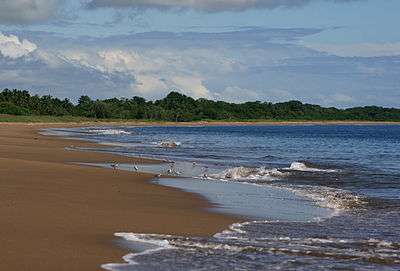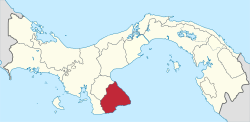Pedasí township, Los Santos
| Pedasí | |
|---|---|
| Corregimiento | |
 Pedasí | |
| Coordinates: 7°32′N 80°2′W / 7.533°N 80.033°WCoordinates: 7°32′N 80°2′W / 7.533°N 80.033°W | |
| Country |
|
| Province | Los Santos |
| District | Pedasí |
| Area[1] | |
| • Land | 114.3 km2 (44.1 sq mi) |
| Population (2010)[1] | |
| • Total | 2,410 |
| • Density | 21.1/km2 (55/sq mi) |
| Population density calculated based on land area. | |
| Time zone | EST (UTC−5) |
Pedasí (Spanish pronunciation: [peðaˈsi]) is a town and corregimiento situated on the south-eastern tip of the Azuero Peninsula on Panama’s Pacific coast. It is the capital of Pedasí District in Los Santos Province.[1] It had a population of 2,410 as of 2010.[1] Its population as of 1990 was 1,494; its population as of 2000 was 1,830.[1]
It is principally a fishing village.[2]
Pedasí’s town boasts a public health clinic, two banks, a library, and a handful of restaurants, mini - supermarkets and small shops. The town is equipped with telephone and Internet service. Pedasí is known for lively annual carnivals, pristine beaches, and activities such as sport fishing, diving and surfing, as well as its proximity to several of Panama’s national parks and preserves.
Pedasí town consists mainly of a central road (Avenida Central), a plaza (city center). About two blocks away are several nicely maintained civic buildings, surrounded by quiet, residential blocks.[3]
With its quaint architecture and neatly laid-out streets, Pedasí is one of the main attractions of the Los Santos region.[4]
Geography
Pedasi is located at the South Eastern tip of the Azuero Peninsula on Panama’s Pacific coast.[5]
Transportation
By car from Panama City, Pedasí is a smooth, roughly five-hour drive on well-maintained roads.[2]
Pedasí is served by the Capt. J. Montenegro Airport (IATA: PDM), via charter or private flights.
Government
Former Panamanian President Mireya Moscoso Rodríguez de Arias, Panama’s first female president, is a Pedasí native. She made it an objective during her term to better the town in which she was born, giving Pedasí improved infrastructure. There is a bust and plaque in the main plaza in her honor.
Attractions

Pedasí town is a little more than three kilometers from the coast, where there are several sandy beaches.
Nearby beaches
- El Arenal (Bajadero)
- Playa El Toro
- Playa La Garita
- Playa El Lagarto
- Playa El Lanchón
- Playa El Cascajal
- Playa Los Destiladeros
- Puerto Escondido
- Playa Los Panamaes
- Playa la Miel
- Punta Chumico
- Playa Venao
Surfing
There are several breaks on Pedasí’s beaches, the most famous local surfer's attraction is Playa Venao at 20 miles from the town. In 2011 and 2012 Playa Venao hosted two World Surfing Championships ISA and boosted a world recognition of the entire area as a top notch Surfing spot, the locals claim there are always waves breaking and closing out in the beautiful bay of Playa Venao. Other more moderate breaks exist, which range from small for beginners, to overhead with the right swell. Playa El Toro has a left and right rock bottom point break for surfing (only one or two times per year with big swell), and Playa El Lagarto has left and right beach breaks (30 yards length for the better). Playa Los Destiladeros also has several breaks for surfing. Kitesurfing is possible during the dry season, January to April, particularly at Playa Arenal.
Sport fishing
Pelagic game fish are abundant because the continental shelf drops sharply relatively close to shore, with year-round catch including amberjack, Pacific sailfish (Istiophorus platypterus), cubera snapper (Lutjanus cyanopterus), roosterfish (Nematistius pectoralis) and grouper, while dorado (Coryphaena hippurus, commonly called mahi-mahi, or dolphinfish), both bigeye tuna (Thunnus obesus) and yellowfin tuna (Thunnus albacares), and wahoo (Acanthocybium solandri) are found seasonally, November through April.
Isla Iguana
Isla Iguana is an island wildlife refuge that can be reached with a 20-minute boat ride from Playa El Arenal. The 52-hectare island is surrounded by an extensive coral reef, which gives it two powdery-soft white sand beaches: Playa El Cirial (252 meters long) and Playita del Faro (37 meters long).
The refuge is home to more than 62 bird species, and a major nesting site for the magnificent frigatebird (Fregata magnificens), with a population of more than 5000. The island also houses several reptile species, including the black iguana (Ctenosaura similis) for which the island is named.
The refuge also comprises a 40-hectare marine area, also migrating humpback whales (Megaptera novaeangliae) between June and October—and one of the largest well-preserved coral reefs in Panama. The reef is home to a variety of fish, rays, eels, and sea turtles.
Architecture
The area’s local architecture is a combination of Colonial Spanish style and modern day masonry block.
Culture
This town plaza is the location where people come to socialize at night. Some men can often be seen wearing cuttarras (traditional sandals) and the region’s folkloric black and white hats; women, during festivals and carnivals, don polleras, traditional hand-stitched multi-layered dresses, some of which can take nearly a year to complete. During local fiestas the women will further adorn their polleras with ornate jewelry and gold chains.
Carnival
Carnival is the annual high point of local life in Pedasí, which is renowned for the most exuberant celebration after Las Tablas. The town divides itself into two factions, Calle Abajo (lower street) and Calle Arriba (upper street), with their respective queens, each trying to outdo the other with floats, music and fireworks. At the end of the celebration, the winning queen is chosen by popular vote.[6]
Pedasí also celebrates the fiesta of Santa Catalina (St Catherine’s Day) on November 25 (see also: Calendar of saints).
References
| Wikivoyage has a travel guide for Pedasi. |
- 1 2 3 4 5 "Cuadro 11 (Superficie, población y densidad de población en la República...)" [Table 11 (Area, population, and population density in the Republic...)] (.xls). In "Resultados Finales Básicos" [Basic Final Results] (in Spanish). National Institute of Statistics and Census of Panama. Retrieved May 26, 2015.
- 1 2 Pedasí: The Azuero Peninsula’s Hidden Gem, Panama Travels
- ↑ A trip to Pedasi is like a trip back in time? ThinkPanama.com
- ↑ Frommer’s Panama, by Kristina Schreck
- ↑ Google Maps World Gazetteer
- ↑ A Review of Panama Carnival, Panama Travels
